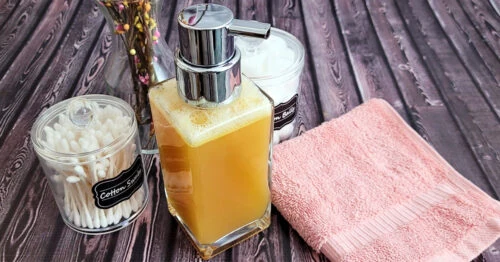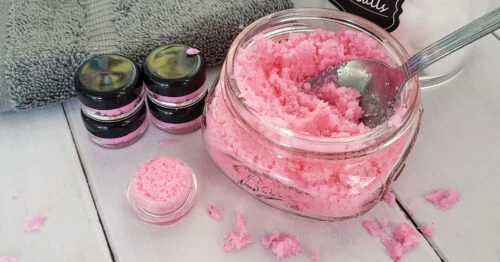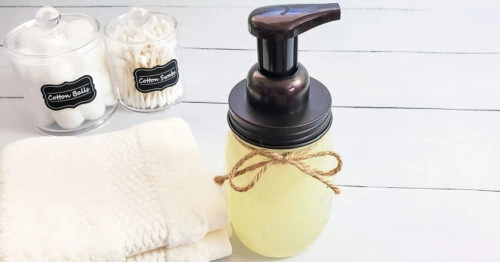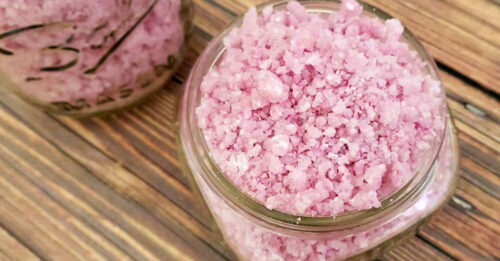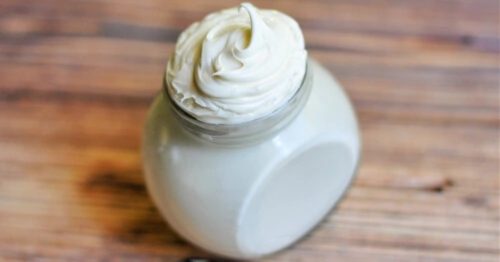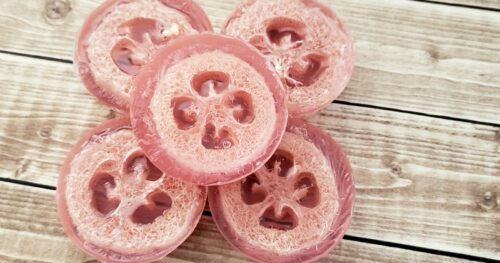What are carrier oils and how do you use them? This guide covers everything you need to know about choosing the best carrier oils for essential oils, including the best options for different uses and skin types, safe dilution ratios for babies through adults, recipes for beauty products and more.
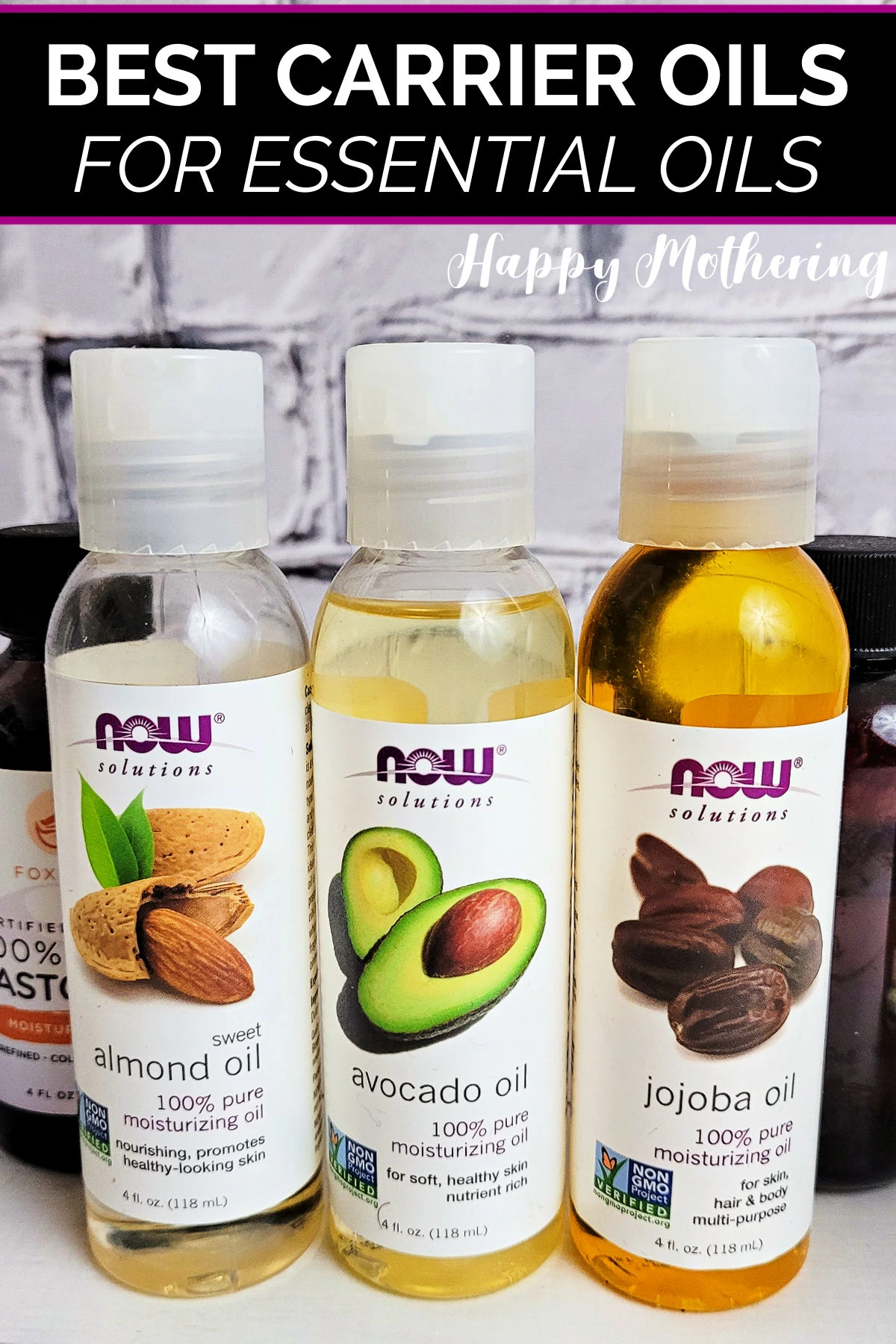
If you’ve been using essential oils for a while, then you have probably used at least one carrier oil before. However, if you’re new to essential oil use, you may not be familiar with the term.
If you don’t have a good resource to reference, you may be scratching your head about what they are and how to use them. In this easy-to-follow guide, I teach you all of the important facts about popular carrier oils so you can use them right away.
After I discuss the different carrier oil options, I also cover how to safely dilute essential oils and share recipes to help you get started. You can read the whole guide or use the Table of Contents to jump to the section you’re most interested in.
- What Are Carrier Oils?
- Why Are Carrier Oils Used?
- Best Carrier Oils for Essential Oils
- 1. Fractionated Coconut Oil
- 2. Regular Coconut Oil
- 3. Jojoba Oil
- 4. Sweet Almond Oil
- 5. Extra Virgin Olive Oil
- 6. Grapeseed Oil
- 7. Rosehip Seed Oil
- 8. Argan Oil
- 9. Vitamin E Oil
- 10. Apricot Kernel Oil
- 11. Sunflower Oil
- 12. Evening Primrose Oil
- 13. Castor Oil
- 14. Emu Oil
- 15. Black Cumin Seed Oil
- 16. Avocado Oil
- 17. Unscented Lotion
- 18. Cocoa Butter
- Oils I Don’t Recommend
- How to Dilute Essential Oils with Carrier Oils
- What About Skin Reactions?
- Ways to Use Diluted Essential Oils?
- Best Places to Buy Carrier Oils
- Best Essential Oil Brand for Families
- Popular DIY Beauty Recipes
What Are Carrier Oils?
Carrier oils are used to dilute essential oils for topical use and create DIY beauty products. They’re typically plant-based, although there are a handful of carrier oils that come from animals.
Unlike essential oils, they’re used as a base oil. They’re also what make your essential oils go a long way if you know how to use them properly.
You want to choose the right carrier oil for your skin type and the type of beauty product you’re planning to make. The good news is that this guide should help you choose a good carrier oil for all of your needs.
Why Are Carrier Oils Used?
It’s not considered safe to use essential oils on skin that haven’t been diluted. Carrier oils help dilute the essential oil so it’s not as potent or hard on the skin.
It’s especially important to use a carrier oil to dilute the potency of essential oils when working with sensitive skin, elderly skin or babies and children.
An added benefit of using a carrier oil is that it can help get the essential oils in to the system in an effective manner and prevent the essential oil from “flashing off” (evaporating).
Best Carrier Oils for Essential Oils
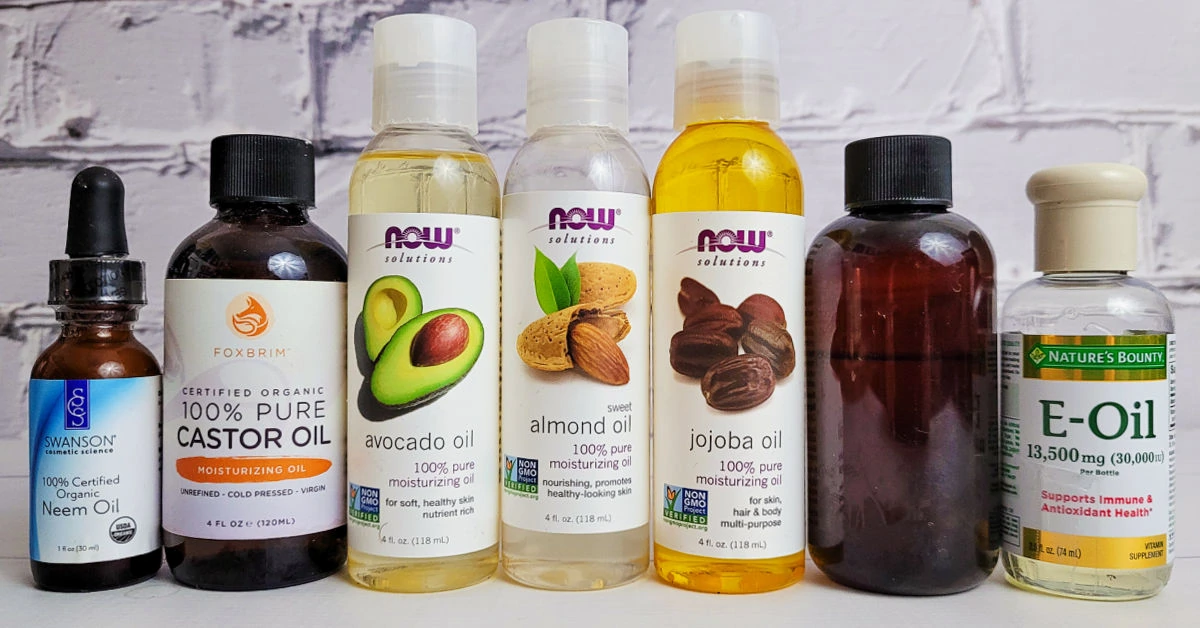
There are so many different carrier oils that it can feel overwhelming to choose one. In this list of carrier oils and their benefits, we’ll talk about the most popular carrier oils, their benefits and pros or cons so that you can make a good choice for yourself and your family.
Many of them have similar benefits, but some have different ones as well. So, depending on what you are using them for, you may want to choose one over another. No matter how you’ll be using them, there’s a perfect carrier oil for every application.
One thing you’ll also need to know is the difference between unrefined and refined oils. Unrefined oils usually have a strong aroma compared to refined oils, which tend to have a more neutral smell. Most commonly I choose refined oils so I have better control over the product’s aroma.
One last factor to consider is the comedogenic scale (how likely something is to clog pores). If you have acne-prone skin, only choose oils with a rating of 2 or less. If you have dry skin, you’ll likely want something rated 3 (and possibly 4) on the comedogenic scale.
1. Fractionated Coconut Oil
This is one of the most common carrier oils you will see listed in recipes or articles and it’s the one that I most often use and recommend. Coconut oil itself is widely known for having a plethora of benefits, and the fractionated version of it is no different in that way.
It has a high concentration of capric and capricylic acids, which are great for your body. The only difference is that the fatty acids have been removed from fractionated coconut oil (FCO) in order to give it a longer shelf life and remove the odor, while preserving its wonderful qualities.
Another benefit of fractionated coconut oil is that it is very thin since the fatty acids have been removed. Unlike normal coconut oil, it’s liquefied and does not get clumpy or thick. It won’t clog your pores and goes nicely on the skin.
If you are using it as a carrier in a roller ball bottle or a pump, you don’t have to worry about FCO clogging it up. I also really like fractionated coconut oil because it has no scent to it at all, so it will not affect the scent of the essential oils you use it with.
Comedogenic Scale: 2-3
Where to Buy: Mountain Rose Herbs, Amazon or Rocky Mountain Oils
2. Regular Coconut Oil
Regular coconut oil makes a great carrier too. It has high levels of lauric acid, a long shelf life and a unique texture compared to other carrier oils. You can also whip it with essential oils and keep it in a jar for all sorts of skin soothing topical applications.
When choosing a coconut oil, select Refined Coconut Oil if you’re like it to smell more neutral. Unrefined coconut oil, often called virgin coconut oil, will have a strong scent of coconuts.
Depending on the time of year, coconut oil can be solid or liquid at room temperature. A lot of body oils and massage oils use coconut oil due to its texture and moisturizing properties.
Comedogenic Scale: 4
Where to Buy: Mountain Rose Herbs or Amazon
3. Jojoba Oil
Jojoba oil has been nicknamed the “Gold of the Desert” and it comes from a desert shrub that can be found in Arizona, Mexico and California. The oil has a golden color and it is odorless, which is a bonus when using with essential oils so that you get the full scent of the oils themselves without interference.
It is moisturizing and emollient, which makes it a great carrier oil for skin and hair, so I like to use it in DIY beauty recipes. It’s a great addition to any hair care or skin care items you may make yourself.
I find it to be the best carrier oil for face products. It hydrates very well so it’s great for dry skin. Our skin excretes an oil called Sebum and Jojoba oil is very similar to it, so for anyone who has an issue with that, it’s a great thing to help their skin issues.
It contains many minerals and it can create glowing skin and help smooth the appearance of wrinkles, stretch marks and other skin issues. It also helps protect the skin from the sun’s effects.
While I love jojoba oil, it’s one of the more expensive carrier oil choices, so I reserve its use for my homemade skincare products.
Comedogenic Scale: 2
Where to Buy: Mountain Rose Herbs, Amazon or Rocky Mountain Oils
4. Sweet Almond Oil
Sweet Almond oil is made from, you guessed it, almonds. It is popular in Southeast Asia and the Mediterranean. It’s wonderful for skin and hair and is used widely in culinary applications as well.
It contains lots of essential fatty acids, vitamins like Vitamin C, Potassium, Zinc and other minerals. So it’s great for anything related to beauty.
It helps reduce the appearance of fine lines, wrinkles and dark circles under the eyes so it can help delay signs of aging. Sweet almond oil also cleanses skin, so it’s a great makeup remover. It can also moisturize chapped lips, hair and the scalp.
There are 2 types of almond oil. One is a bitter oil that can be toxic to your body, so always be sure the bottles says “Sweet” in the title when making essential oil combinations.
Comedogenic Scale: 2
Where to Buy: Mountain Rose Herbs, Amazon or Rocky Mountain Oils
5. Extra Virgin Olive Oil
EVOO, as it is commonly called, is an excellent carrier oil to start out with if you’re new to using them, as most people already have it in their home and it can be less expensive than some of the other oils.
It is one of the only cooking oils that is made by mechanical means with no solvents or chemicals to affect the oil’s properties. Extra virgin olive oil is made by crushing the olives and extracting the juice.
It is an excellent moisturizer and wonderful for anything skin related. Some of its best uses are for makeup remover, nail care and salves for various skin conditions like my Calendula Lavender Skin Salve.
Comedogenic Scale: 2-3
Where to Buy: Amazon or Kosterina
6. Grapeseed Oil
Grapeseed oil is exactly what it sounds like and is extracted from the seeds of grapes. Most commonly, grape seed oil is made from the seeds of wine grapes, which would otherwise be thrown away, so it helps to use up the plant fully.
One con to it is that is it chemically extracted from grape seeds, which does affect the scent and the flavor of the oil somewhat. It makes for a nutty aroma, and makes the oil more affordable for consumers. I tend to choose cold-pressed oils over chemically-extracted oils.
It is a polyunsaturated oil that contains high levels of linoleic acid, and this type of oil can go rancid faster than others so I wouldn’t recommend buying it in large quantities. I personally tend to avoid it, but it’s easily accessible at the grocery store if you need something easy to buy locally.
It is a thinner oil so it works well as a carrier when making massage essential oil mixes. It can be useful for skin, cosmetics and culinary use.
One thing to note about using grapeseed oil is to be sure you purchase the “food grade” type. Refrigerate it or store in a cool, dark place to keep it from going rancid too quickly.
Comedogenic Scale: 1
Where to Buy: Mountain Rose Herbs or Amazon
7. Rosehip Seed Oil
Another oil you’ll frequently see in DIY beauty recipes is Rosehip Oil. It’s traditionally added to recipes where you really want to boost the moisturizing benefits.
Rose hip oil is great to use in homemade skincare products like face creams. It contains high levels of Vitamin C and Vitamin A, so it can help brighten skin. It’s also full of fatty acids and antioxidants, so if you have dry skin, you’ll want this moisturizing ingredient on hand.
I don’t typically use it as a carrier oil on its own, but I use it along with jojoba oil or sweet almond oil for a mixture to apply to my face. It’s also great to use as a carrier oil for hair recipes either with argan oil or on its own.
Comedogenic Scale: 1
Where to Buy: Mountain Rose Herbs or Amazon
8. Argan Oil
Argan Oil is another wonderful carrier oil to consider that has so many benefits. It’s more of a medium-weight oil, so it’s great for multiple skin types and it’s one of the best carrier oils for hair.
It’s also a great choice for acne-prone skin since it can help to balance out the amount of sebum on skin. Argan oil can also help to encourage a calmer and smoother complexion for these challenging skin types.
Used on its own, it can be applied after moisturizers, but it makes a great addition to homemade skincare products.
Comedogenic Scale: 0
Where to Buy: Mountain Rose Herbs or Amazon
9. Vitamin E Oil
While I don’t recommend using Vitamin E oil as the only carrier oil in any given recipe, it makes an excellent choice for homemade skincare products. It helps to prevent oxidation in other oils, so it can extend the shelf life of homemade beauty products (it’s not a preservative though).
Vitamin E oil can also act as a free-radical scavenger, so it can help protect skin from damage. It’s super versatile and I add it to a lot of my recipes such as:
Comedogenic Scale: 2
Where to Buy: Mountain Rose Herbs or Amazon
10. Apricot Kernel Oil
Apricot kernel oil is a very nourishing carrier oil that’s great for dry skin. Like its name implies, this carrier oil is made from the kernels of apricots.
Since it’s so nourishing, it can help reduce the appearance of fine lines and wrinkles. It’s rich in essential fatty acids and vitamins A (from beta carotene), C and E.
Comedogenic Scale: 2
Where to Buy: Mountain Rose Herbs or Amazon
11. Sunflower Oil
While I don’t typically use sunflower oil in my beauty recipes, it can be used as a carrier oil for essential oils. It’s very moisturizing and contains vitamin E and linoleic acid, both of which are great for skin.
If you want to use sunflower oil, be sure to choose cold-pressed. If the bottle doesn’t say cold pressed on it, it’s likely chemically extracted from sunflower seeds instead.
Comedogenic Scale: 0-2
Where to Buy: Mountain Rose Herbs or Amazon
12. Evening Primrose Oil
Prior to making my own beauty products, I was only familiar with evening primrose oil and its uses for pregnant women. However, it’s also great for everyday skincare products!
Evening primrose oil has emollient properties, which essentially means that it can help to improve skin’s texture by smoothing and softening it. It’s really great for dry skin as it’s been shown to improve moisture balance.
Comedogenic Scale: 2-3
Where to Buy: Mountain Rose Herbs or Amazon
13. Castor Oil
Another oil commonly talked about among pregnant women, castor oil is a great choice for skincare products if you have dry skin. It’s actually a humectant, which means it can draw moisture out of the air and into your skin.
In addition, it helps to prevent moisture evaporation from the top layer of skin. Best of all, it does a great job at moisturizing skin without clogging pores so it can be used with all skin types, including sensitive skin.
Comedogenic Scale: 1
Where to Buy: Mountain Rose Herbs or Amazon
14. Emu Oil
Emu oil is another amazing moisturizer that works well for all skin types. I rubbed it on my belly every day when I was pregnant and it really helped my skin to feel more supple.
If you’d like to include a non-plant-based oil in your skincare regimen with wonderful moisturizing properties, emu oil is a great choice. Just consider that it’s not a cruelty-free ingredient.
Comedogenic Scale: 1
Where to Buy: Amazon
15. Black Cumin Seed Oil
Black Cumin Seed Oil, sometimes just referred to as black seed oil, has a long history of use in skincare products, dating all the way back to at least ancient Egypt.
While it’s one of the few carrier oils I haven’t worked with myself (yet), it’s a great moisturizer that can be used with all skin types. It can also help reduce the appearance of fine lines and wrinkles.
Comedogenic Scale: 2
Where to Buy: Mountain Rose Herbs or Amazon
16. Avocado Oil
Some people also really love to use avocado oil as a carrier oil. I cook with it all the time, but don’t tend to reach for it with my essential oils unless I’m making a formulation for really dry skin.
If you have a dry, itchy scalp, try moisturizing with avocado oil. Just keep in mind that it’s higher on the comedogenic scale, which means it’s not a good choice for acne-prone skin.
Comedogenic Scale: 3
Where to Buy: Mountain Rose Herbs or Amazon
17. Unscented Lotion
An unscented lotion that is natural and does not contain any fillers or perfumes is another great way to apply oils as well. I like to mix the essential oils into the lotion in my hand just before applying to my skin.
Comedogenic Scale: Varies (read ingredients)
Where to Buy: Mountain Rose Herbs or Amazon
18. Cocoa Butter
If you have extremely dry skin, consider adding a butter like cocoa butter to your formulation. Butters are much more moisturizing than oils, so they’re great for this purpose.
There are tons of butters to choose from if the scent of cocoa butter will offset the aroma of your product too much. Some other options include shea butter and mango butter.
Comedogenic Scale Rating: 4
Where to Buy: Mountain Rose Herbs or Amazon
Oils I Don’t Recommend
There are so many oils on the market, and some aren’t suited for use as carrier oils. Some of those oils I don’t recommend include:
- Vegetable Oils
- Mineral Oil
- Vegetable Shortening
- Petroleum Jelly
Now that you know which carrier oils will work best for you (and which ones won’t), let’s talk about how to mix essential oils with carrier oils for safer use.
How to Dilute Essential Oils with Carrier Oils
A common question when diluting essential oils with a carrier oil is what ratio of essential oil to carrier oil is best.
Here is the recommended ratio for diluting essential oils with a carrier oil. You never want to apply undiluted or overly high concentrations of essential oils directly to your skin.
You will have to take into account that everyone is different, and people react differently to the oils. Some need more, some need less, so use caution and common sense with essential oil blending.
1. Dilute essential oils for babies.
For babies use a 0.3% dilution ratio. This would be about 1 drop of essential oil to 1 tablespoon of the carrier.
2. Dilute essential oils for kids.
For kids, use a 1.0% dilution ratio. That’s about 1 drop of essential oil to 1 teaspoon of the carrier.
3. Dilute essential oils for adults.
For adults, use a 2.0%- 4.0% dilution ratio. This is around 3-6 drops of essential oil to 1 teaspoon of the carrier.
For a 10 ml roller bottle, I use about 10 drops of whatever essential oil I am using, and then top it off the rest of the way with a carrier oil.
Please note that if you are using the oils aromatically, a carrier oil is not needed. It is only for use on the body itself. Do not add carrier oils to your essential oil diffuser or it will clog it up.
Also, please do not ingest essential oils without the guidance of an aromatherapy professional (MLM representatives are almost never certified to give professional advice).
What About Skin Reactions?
If you experience any adverse reactions such as skin irritation or an allergic reaction, immediately stop the use of that carrier oil or essential oil. I always recommend doing a patch test with any new oil you’re using before applying it to a larger area of skin.
It’s best if you can apply just the carrier oil alone in a patch test so you know if it’s the carrier oil or the essential oil you’re reacting to. I don’t typically recommend patch testing undiluted essential oils, which is why it’s ideal to patch test the carrier oil and if you don’t react to that, then you can patch test the diluted essential oil.
Ways to Use Diluted Essential Oils?
Now that you know the best carrier oils for essential oils and safe dilution ratios, let’s talk about ways to use those diluted oils.
In most cases, when using essential oils, they are applied topically to the skin, either on the area of the body that needs extra support, or the bottoms of the feet on reflex points.
For example, let’s say you are dealing with head tension and want to use some lavender and peppermint on your head for soothing.
You would open the bottles up first, put the desired amount of carrier oil in your hand, then add a drop or two of the essential oils and mix. Then apply the diluted mixture to your head, temples, etc.
Or you can use any number of essential oil recipes for different uses.
Make Roll On Essential Oil Blends
I like to buy empty roller bottles and make my own blends in them since we have several we use frequently. That way it’s already diluted with the carrier oil so it saves time, and it makes the essential oil go further, which saves money too!
If you have leftover roller bottles, try making my DIY Lip Gloss Rollers recipe!
Make Balms and Salves
I love making balms and salves even more than roller bottle formulas because they tend to last so much longer. The way they’re made helps to really seal in the benefits to your skin.
Some of my favorite essential oil balm recipes include:
- Headache Balm
- Allergy Relief Balm
- Menstrual Cramps Salve
- Sinus Relief Balm
- Dry Skin Balm
- Calendula Lavender Salve
DIY Beauty Product Recipes
There are so many homemade beauty products you can make once you understand how to safely use essential oils. These are some of my favorite beauty recipes, but I have a ton of DIY Beauty Recipes for you to test out:
Best Places to Buy Carrier Oils
There are a ton of places to buy carrier oils, but I really only trust a handful of brands with my family. Here are my top 5 favorite places to shop for carrier oils:
Best Essential Oil Brand for Families
If you’re curious abut what brand of essential oils I use, I switched to Rocky Mountain Essential Oils a couple years ago after leaving the MLM industry. They have super pure essential oils that smell amazing and last a long time. And they’re a much better choice than the unknown brands you see on Amazon.
If you compare their Starter Kit to the other popular brands out there like doTERRA and Young Living, you’ll find it’s incredibly affordable and you don’t have to pay for a membership either. It’s the best way to get started with high-quality essential oils as the kit contains 5 ml bottles of these popular oils:
- Lavender oil
- Peppermint oil
- Tea Tree oil
- Lemon oil
- Orange oil
- Rosemary oil
The Rocky Mountain Oils Starter Kit really is the best value if you’re just getting started with essential oils and want to make sure that the oils you’re buying are not only the highest quality, but ones you’ll actually use too.
Knowing how to use carrier oils to dilute essential oils is an important topic for families. I hope this information helped you discover the best carrier oil for your needs and that you have a lot of fun discovering new essential oils recipes to make.
To learn more about using essential oils with your family, be sure to check out the Essential Oil Binder from Nourishing Joy.

